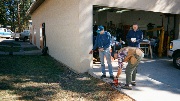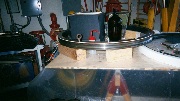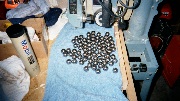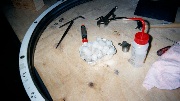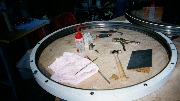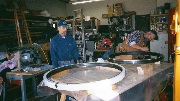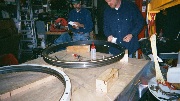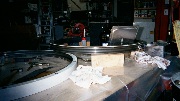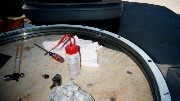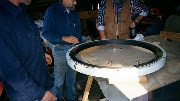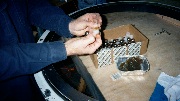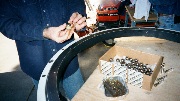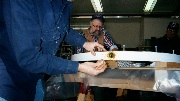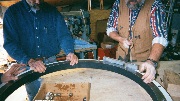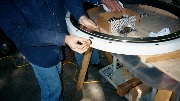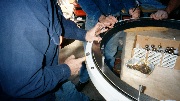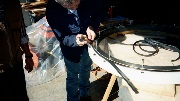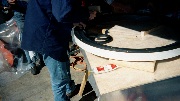Disassembling and Cleaning the Instrument Rotator Bearing on the Sloan Telescope,Results of 10/27/00 Introduction:
This procedure is intended to document the disassembly and cleaning of the Rotek bearing that supports the instrument rotator on the Sloan 2.5 m telescope. The first time this procedure took place was at APO on 10/27/00. I don't have any pictures of ball removal because by the time I arrived at APO the balls had already been removed from the bearing. The general concensus about the condition of the bearing was that it looked brand new, hardly used after it was cleaned up.
The procedure is very straightforward. Remove the bearing from the telescope is the first step, which requires removing the instrument rotator. The balls are held in the bearing by a plug in the outer race which is held in by a tapered pin. You knock out the pin, remove the plug and you can extract the balls and plastic spacers from the bearing. Everything is then cleaned with solvents and ultrasound (for the balls and spacers), and then repacked with the correct grease.
The BOM for this bearing from L&F calls out Moly-coat and .33 lbs of a generic grease equivalent to the Shell Alvania EP2. Other greases that work are Mobilith AW2, (a mineral oil-based grease,) and Mobilith SHC-220 (the synthetic oil-base equivalent to the AW2). The balls and spacers are then reinstalled. The technician from Rotek, Todd Troyer, who repacked the grease on the balls and spacers did not measure out the weight of the grease, just used the standard finger method familiar to any mechanic.
Click on any of the thumbnails below for a larger version of the picture.
This technique should also be familiar to any garage mechanic.
This is how we cleaned the balls and spacers.
The steel cylinder with the radius cut from it next to the squeeze bottle is the plug for the outer race. Behind it is the tapered pin. One of the interesting things we learned is that the plug is made from a softer steel than the rest of the race. It is also relieved to have its inside surface below the surface of the rest of the race so the balls do not pass over it with a significant force. If it were flush with the race surface the pressure from the balls would groove its softer material degrading it.
The external paint of the races could have been scraped into the race during reassembly, so it was removed near the gap between the inner and outer races.
The inner race was lowered by hand into the outer race. Next is putting in balls and spacers.
The grease on the spacer is used during assembly to stick the ball to something you can hold.
The Rotek bearing balls are preloaded into the races, meaning that as you load the balls in the bearing gets tighter and harder to rotate by hand. French whipped up this clever fixture to get enough leverage to turn the bearing each time a ball and spacer was added.
Todd, the Rotek technician, has a custom made stainless steel tool for reinstalling seals. The process is simply to carefully bang the new seal in place all the way around. One of the old seals was very cracked and old looking. The other wasn't as bad, but they were both replaced.
Seals are put in with this yellow rubber cement. Once the seals were glued in the bearing was ready for reinstallation.
Back to the Bartoszek Engineering Sloan Digital Sky Survey Page
Back to the Bartoszek Engineering Projects Page
Back to the Bartoszek Engineering Home Page
|
